NISAR Instrument
India’s Space Achievements
India’s space programme, led by the Indian Space Research Organisation (ISRO), is undergoing a transformation marked by bold ambitions, technological innovation, and increasing global collaboration.
Over 400 satellites for 34 nations have been launched on India’s launch vehicles.
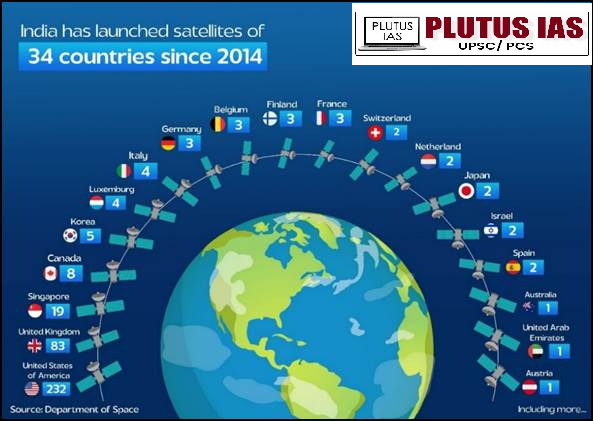
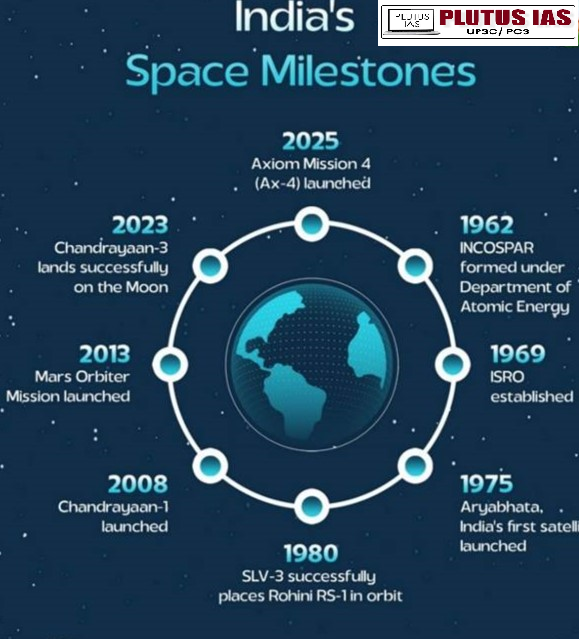
India’s First Human Spaceflight to the International Space Station: Axiom-4 Mission
The successful culmination of the Axiom Mission 4 (Ax-4) marks a transformative chapter in India’s space journey. Launched on 25th June 2025, this historic mission enabled India, Poland, and Hungary to conduct their first government-sponsored human spaceflights in over four decades, with all three nations achieving human presence aboard the International Space Station (ISS) for the first time. Spearheaded by Axiom Space, this mission exemplifies the growing democratization of access to space and the strengthening of national space capabilities through international collaboration.
India’s Landmark Human Spaceflight Milestone
Group Captain Shubhanshu Shukla, representing India as the Mission Pilot, became the first Indian astronaut to travel to the ISS, marking a defining achievement in the nation’s human spaceflight history. His journey and 18-day stay aboard the ISS signal a new era of Indian ambitions in low-Earth orbit exploration. After a 22.5-hour return journey, the crew returned to Earth aboard the SpaceX Dragon capsule ‘Grace’, which splashed down in the Pacific Ocean off the coast of San Diego at approximately 3 PM IST on 15th July 2025.
This mission lays a strong foundation for India’s upcoming Gaganyaan programme and the long-term vision of establishing the Bharatiya Antariksha Station, highlighting India’s commitment to sustained human presence in space.
Scientific Contributions and Experiments Onboard ISS
1. Microalgae Experiment: Three strains of microalgae were studied under artificial light to evaluate the effects of microgravity on their growth and behaviour.
2. Seed Sprouting in Space: Moong and methi seeds were successfully sprouted through controlled hydration. The results hold promise for developing space-based nutritional strategies.
3. Tardigrade Strain Study: An Indian strain of dormant tardigrades was revived and observed in microgravity, offering insights into biological survival under extreme space conditions.
4. Myogenesis and Metabolic Supplements: The experiment studied muscle cell behavior and the role of nutritional supplements in countering muscle degradation in microgravity.
5. Cyanobacteria Growth: The growth of cyanobacteria in urea and nitrate media was monitored to assess their use in life support systems and bioengineering applications in space.
6. Human-Machine Interface Testing: A series of web-based assessments analyzed how microgravity influences human interaction with electronic displays, aiming to improve user interfaces for astronauts.
7. Space Agriculture Studies: Seeds of crops like rice, cowpea, sesame, brinjal, and tomato were passively exposed to space. Upon return, they will be cultivated to examine possible inherited traits or adaptations due to space exposure.
Gaganyaan Programme: India’s Leap into Human Spaceflight
India’s space ambitions took a major leap forward with the Gaganyaan Programme, the country’s first indigenous human spaceflight initiative, approved with a substantial financial outlay of ₹20,193 crore. Spearheaded by the Indian Space Research Organisation (ISRO), this flagship mission aims to send Indian astronauts into Low Earth Orbit (LEO), marking a defining milestone in India’s journey as a spacefaring nation.
This investment supports key technology development activities and a total of eight planned missions, including both uncrewed and crewed flights. Four Indian Air Force test pilots have been selected and have completed their physical, psychological, and generic spaceflight training-
Gp Capt. PB Nair
Gp Capt. Ajit Krishnan
Gp Capt. Angad Pratap
Gp Capt. S Shukla
They are set to become India’s first astronauts in independent spaceflight, marking a new chapter in national scientific achievement. Before the crewed mission, three uncrewed test flights will take place, with first one scheduled for this year from Sriharikota. After successful testing, the crewed mission will follow. Additionally, astronauts will undergo rigorous physical and training modules to ensure mission readiness.
As of May 2025, the programme entered its final phase with the first human spaceflight now scheduled for the first quarter of 2027. Currently, the Human-rated LVM3 vehicle, the Crew Escape System, and the Crew Module and Service Module are all undergoing final stages of testing and integration, while training of astronauts is also progressing steadily.
Scientific focus: Developing and validating technologies necessary for safe human spaceflight, along with laying the groundwork for advanced space science research in microgravity environments. The mission includes precursor and demonstration missions, which are essential for the future construction and operation of the Bharatiya Antariksh Station (BAS), India’s planned space station. These scientific objectives are closely aligned with India’s broader vision during Amrit Kaal, for space exploration. Additionally, the program is expected to spur increased industrial participation and economic activity, generating employment, particularly in high-tech fields related to space and allied industries.
Safety of Human Spaceflight: When an object with high velocity re-enters the Earth’s atmosphere, it generates significant heat. To address this, ISRO is developing and demonstrating advanced thermal protection systems to ensure safe re-entry. In the final phase, the spacecraft will be slowed to a precise, controlled velocity using parachutes, ensuring a safe and accurate landing.
Chandrayaan
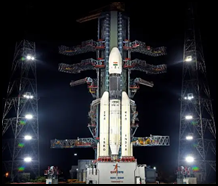 1. Chandrayaan-1: Launched on October 22, 2008, Chandrayaan-1 was India’s first mission to the Moon.
1. Chandrayaan-1: Launched on October 22, 2008, Chandrayaan-1 was India’s first mission to the Moon.
It orbited the Moon, deployed the Moon Impact Probe, and performed high-resolution mapping and mineralogical studies. Chandrayaan-1 confirmed the presence of water molecules at the lunar poles and marked India’s entry into deep space exploration.
2. Chandrayaan-2: Launched on July 22, 2019, Chandrayaan-2 comprised an orbiter, lander (Vikram), and rover (Pragyan).
Although the lander did not achieve a soft landing, the mission was a success in terms of scientific data collection and technological advancements. The mission expanded India’s lunar capabilities and scientific research.
3. Chandrayaan-3: Launched on July 14, 2023, Chandrayaan-3 marked a historic achievement for India as it successfully landed near the Moon’s south pole.
This mission made India the first country to achieve a soft landing in this region, which is of great scientific interest due to its permanently shadowed craters that may contain water ice.
The lander (Vikram) and rover (Pragyan) successfully explored the surface, conducting thermal, seismic, and chemical analyses. Chandrayaan-3 made India the first country to land on the lunar south pole and furthered scientific knowledge of lunar soil and the environment.
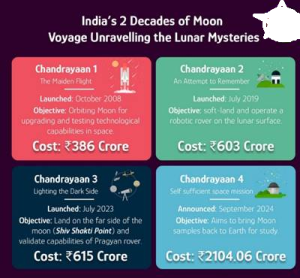
4. Chandrayaan-4: Building on the success of Chandrayaan-3, Chandrayaan-4 will have a 9,200 kg satellite, this mission will involve sample collection and further experiments on the Moon’s south pole.
The mission’s complexity and scale highlight India’s growing capabilities in lunar exploration.
Due to its size, it will be launched in two Mark III rockets, assembled in five modules with two stacks.
These modules will dock in Earth’s orbit, where the propulsion system will be separated. Four modules will travel to the Moon’s orbit, with two eventually landing on the surface. The sample return module will only return to Earth, docking with the other two modules in lunar orbit.
Mars Orbiter Mission (Mangalyaan): A Milestone in Planetary Exploration
The Mars Orbiter Mission (MOM), popularly known as Mangalyaan, was India’s first interplanetary mission, launched aboard PSLV-C25 on 5th November 2013. With its success, India became the first Asian country and fourth space agency globally to reach Mars orbit—on 23rd September 2014—and did so in the first attempt, earning international acclaim for cost-effectiveness and mission planning

Technological Objectives
Design and operation of a Mars orbiter capable of:
1. Earth-bound manoeuvres, 300-day cruise, and Mars Orbit Insertion
2. On-orbit operations around Mars
3. Development of deep space communication, navigation, and mission management systems
4. Incorporation of autonomous systems to handle contingencies
Scientific Objectives
1. Study of Mars’ surface features, topography, mineralogy, and atmosphere using indigenous instruments
2. Mars Colour Camera captured over 500 images, aiding planetary research
3. Enabling scientific data generation and research opportunities for Indian scientists
NavIC (Navigation with Indian Constellation)
NavIC is a satellite-based navigational system, developed by the Indian Space Research Organisation (ISRO), which enables users to determine their precise geographic location and track their movements anywhere in India and 1500 km beyond India’s territorial boundary.[15] NavIC can help in navigation on land, air, sea and also in disaster management. NavIC satellites are placed in geostationary orbit (GEO) & geosynchronous orbit (GSO) with an altitude of about 36,000 km; GPS satellites are placed in medium earth orbit (MEO) with an altitude of about 20,000 km
India’s Space Sector: Policy, Investment, and Private Sector Growth
| Category |
Details |
| FDI Policy (2024) |
100% FDI allowed under revised policy:
• Up to 74% (Automatic): Satellites, data products, ground/user segments
• Up to 49% (Automatic): Launch vehicles, spaceports
• Up to 100% (Automatic): Components & subsystems
• Beyond limits: Government route |
| India Space Policy 2023 |
Encourages private participation across entire space value chain—manufacturing, launches, services, and ground infrastructure |
| Space Vision 2047 |
Long-term roadmap for:
• Bharatiya Antariksha Station (BAS)
• Crewed lunar missions
• Next-gen launch vehicles
• Venus and deep space missions |
| Key Institutions |
• IN-SPACe (2020): Nodal agency for private participation
• Antrix Corp (1992): Original commercial arm
• NSIL: Commercialisation & industry support using ISRO tech |
| Budget Growth |
Increased from ₹5,615 Cr (2013–14) to ₹13,416 Cr (2025–26) – nearly tripled in a decade |
| Mission Successes |
• Over 100 successful ISRO launches in 11 years |
| Private Sector Growth |
• 328+ space startups emerged
• Supported by policy reforms, VC fund, and IN-SPACe facilitation |
| Innovation Initiatives |
• SpaDeX Mission: Tackling space debris
• Growth of high-tech jobs and industrial participation driven by open policy ecosystem |
Way Forward
1. PSLV-C61/EOS-09 Mission: PSLV will launch EOS-09, a state-of-the-art microwave remote sensing satellite with a C-band synthetic aperture radar, capable of imaging surface features day and night in all weather.
2. TV-D2 Mission: The second Test Vehicle mission will demonstrate Gaganyaan Crew Escape System by simulating an abort scenario. The Crew Module will separate and descend using thrusters and parachutes before sea splashdown, followed by recovery operations.
3. GSLV-F16/NISAR Mission: The NASA-ISRO NISAR Earth science satellite, using dual L & S band RADAR, will monitor Earth’s ecosystems and hazards. ISRO provides the satellite bus, integration, testing, launch vehicle, and S-band payload; NASA supplies the L-band payload, antenna, recorder, and GPS.
4. LVM3-M5/BlueBird Block-2 Mission: A commercial launch for AST SpaceMobile Inc., USA, of BlueBird Block-2 satellites under agreement with NSIL.
Conclusion
India’s space programme stands at a defining moment in its history, as it transitions from a journey of exploration to a mission of leadership. Group Captain Shubhanshu Shukla’s pioneering role aboard Axiom Mission 4 is more than a personal milestone, it is a national triumph that reflects India’s evolving capabilities and global stature in space science. Through cutting-edge research, strategic partnerships, and a robust vision encapsulated in initiatives like Gaganyaan and the Bharatiya Antariksh Station, India is laying the groundwork for a sustained human presence in space. The convergence of policy reforms, private sector participation, and technological ambition ensures that the space sector will not only drive scientific progress but also fuel innovation and economic growth. As India prepares for its first independent human spaceflight and ventures towards the Moon and beyond, it signals to the world that the future of space will be shaped by nations that dare to dream and have the resolve to act, and India is firmly among them.
Prelims Questions
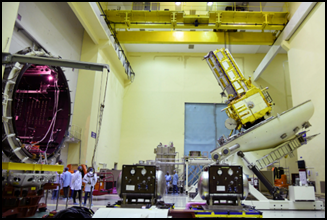










No Comments